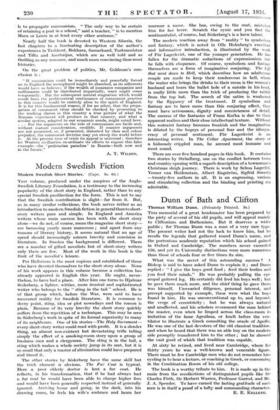Modern Swedish Fiction
Modern Swedish Short Stories.' (Cape. 8s. 6d.) THIS volume, produced under the auspices of the Anglo- Swedish Literary Foundation, is a testimony to the increasing popularity of the short story in England, rather than to any special Swedish predilection for the form. This is not to say that the Swedish contribution is slight—far from it. But, as in many similar collections, the book serves rather as an introduction to modern Swedish fiction in general than to short- story writers pure and simple. In England and America writers whose main success has been with the short story alone—we do not, of course, mean the magazine short story— are becoming yearly more numerous ; and apart from any reasons of literary history, it seems natural that an age of speed should increasingly esteem brevity and concision in literature. In Sweden the background is different. There are a number of gifted novelists but of short-story writers only there are few. Most of the work in this book is the fruit of the novelist's leisure.
Per liallstrom is the most copious and established of those • who have devoted themselves to the short story alone. None of his work appears in this volume because a collection has already appeared in English this year. He ought, never- theless, to have had a place. After him one turns to Hjalmar Soderberg, a lighter, wittier, more ironical and sophisticated writer who belongs to the "sting in the tail" school. He is of that group which, before the War, were said to have recovered reality for Swedish literature. It is common to decry point, sting, idea or plot nowadays and the reason is plain. - Because of its very brevity the short story quickly suffers from the repetition of a technique. This may be seen in Soderberg's work in spite of its formal superiority to many of its neighbours. One of his stories—The Holy Sacrament— every short-story writer could read with profit. It is a slender thing, an almost non-existent but devastating trifle telling simply the effect of a smoking-room story upon a group of business men and a clergyman. The sting is in the tail, a sting which makes a whole society jump in its seat, but it is so small that only a master of elimination could have prepared and timed it.
The other stories by Soderberg have the same skill but the trick element is obvious. The Fur Coat is typical. Here a poor elderly doctor is lent a fur coat. He reflects, in his transformation, that if he had always had a fur coat he would have been able to charge higher fees and would have been generally respected instead of generally ignored. Arriving home and going, in the dark, into his drawing room, he feels his wife's embrace and hears her
murmur a name. She has, owing to the coat, mistaken him for her lover. Scratch the cynic and you find the sentimentalist, of course, but Soderberg's is a keen talent.
The modern reaction away from " reality " to symbolism and fantasy, which is noted in 011e Holmberg's excellent and informative introduction, is illustrated by the work of Par Lagerkvist, one of the younger generation. He has fallen for the dramatic seductions of expressionism but he falls with eloquence. Of course, symbolism and fantasy themselves are a form of imaginative conjuring. The Lift that went down to Hell, which describes how an adulterous couple are made to keep their rendezvous in hell, where
• the waiter who brings the drinks to their room is the woman's husband and bears the bullet hole of a suicide in his head, is really little more than the trick of producing the rabbit from the top hat. The scorch of the satire is weakened by the flippancy of the treatment. If symbolism and fantasy are to have more than this conjuring effect, they must have seriousness, dignity and concreteness of detail. The success of the fantasies of Franz Kafka is due to their apparent realism and their close intellectual texture. Without this restraint fantasy becomes freakish and the imagination is diluted by the bogeys of personal fear and the idiosyn- crasy of personal sentiment. Par Lagerkvist is an interesting writer. In The Cellar Apartment, the story of a hideously crippled man, he seemed most humane and most sound.
There are over five hundred pages in this book. It contains two stories by Strindberg, one on the conflict between town and country opening with a superb description of a townsman's Christmas sleigh journey. There is work by Selma Lagerltif, Verner van Heidenstam, Albert Engstrom, Sigfrid Siwertz —twenty-five authors in all. It is an engrossing, various and stimulating collection and the binding and printing are admirable.


































 Previous page
Previous page